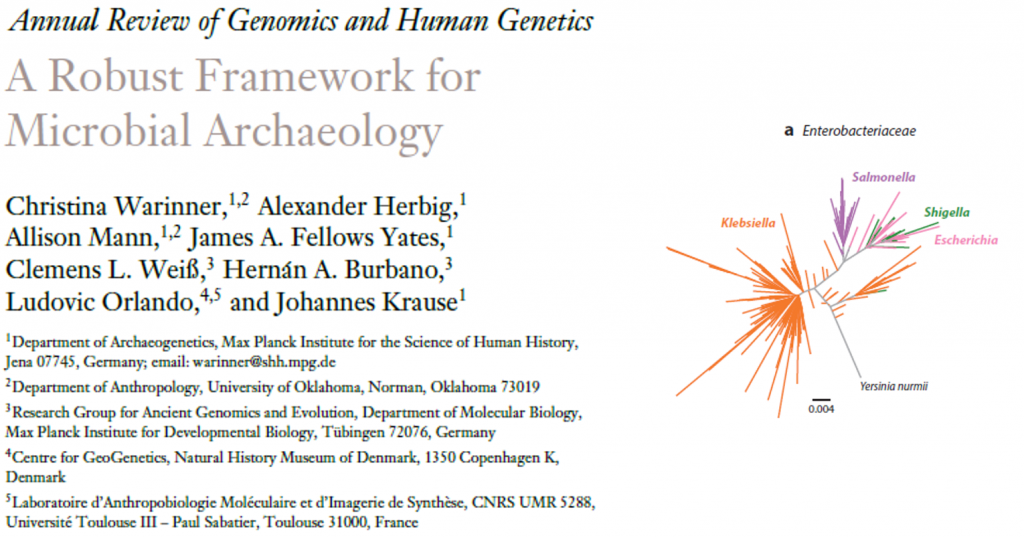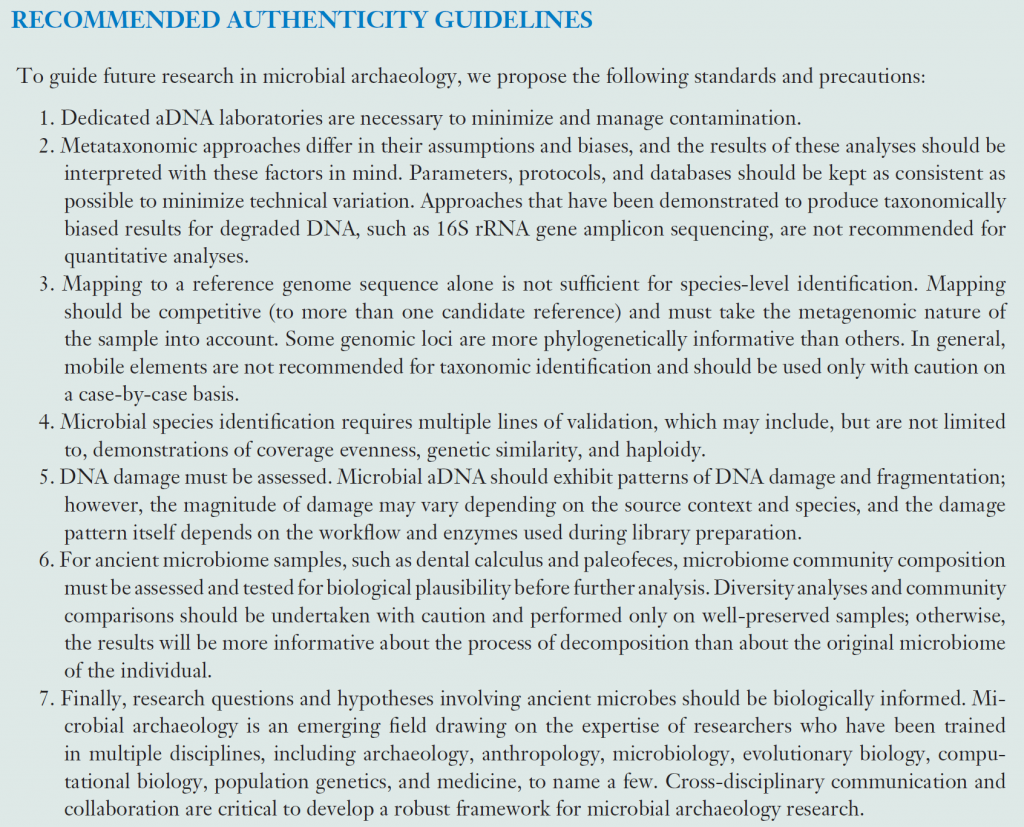
Source: Warinner, C., Herbig, A., Mann, A., Fellows Yates, J. A., Weiß, C. L., Burbano, H. A., … & Krause, J. (2017). A robust framework for microbial archaeology. Annual review of genomics and human genetics, 18, 321-356. https://www.annualreviews.org/doi/abs/10.1146/annurev-genom-091416-035526
The relationship of humans and bacteria is complex and unique. No other organism, or community of organisms, has been with us long enough to be considered a co-evolutionary partner across both time and space. And yet, recognizing microbes (by virtue of size and difficulty in classification) and their exact role has been difficult, especially when considering their possible role in archaeology. In attempting to create a “robust framework” for microbial archaeology, Warinner and his partners highlight both the potential and the challenges of understanding this subject.
The authors represent a cross-disciplinary group, with backgrounds in anthropology, molecular anthropology, genetics, and the emergent field of archaeogenetics; however, none of the authors appear to be practising archaeologists. Furthermore, the keywords chosen for the paper (“ancient DNA, metagenomics, bacteria, pathogens, microbiome, high-throughput sequencing”) give further warning that this is a biology paper, focused on ancient DNA and the microbial genome. The paper was published in 2017 (written earlier), and the research cited was focused mostly on pathogenomics (microbes as the cause of disease) and microbiome studies (understanding the relationship of microbial communities and their interactions with the host during both health and diseases states).
Since the review was published, the use of bacteria in archaeology has expanded, and new directions of study have emerged. For example, greater use is being made of microbes in studying food pathways (e.g.: Gancz et al., 2023), floral and fauna distribution (e.g. Alaoui-Sosse et al., 2023), climate and geographic changes (Perez et al., 2023), and even as microorganisms artifacts in their own right. Klapper et al. (2023) have used ancient DNA extracted from microorganisms to identify natural product use by early hominins, and they may be able to identify bioactive products that have been lost to time. Other authors have reported that soil from different Roman occupational layers can be differentiated by the microbial signature (Taylor et al., 2023). In a field where the amount of published research can double in 3 to 4 years, a new review may be warranted to ensure that both biologists and archaeologists appreciate the benefits and challenges of using microorganisms in their work.
The initial issue that the review’s authors highlight is identifying specific microorganisms, and determining if they represent an endogenous species associated with a particular archaeological assemblage, or if they are a post-mortem contaminant. In spite of successful viral analysis (mostly with various diseases such as the Spanish influenza strain of 1917 by researchers such as Goh et al., 2023), the authors have focused on bacteria. The paper highlights the rigour required for positive identification of bacteria, especially the testing methodologies required: polymerase chain reaction, 16S rRNA sequence analysis, and multilocus sequence analysis. The authors provide an excellent description of these technologies, as well as the issues around looking at a particular locus of the DNA versus techniques that examine the entire genome of the bacteria. As noted in the paper, the complexities of these procedures increase when one considers the natural variations in that occur in bacterial genomes as well as the potential for contamination or destruction of the sample at all stages between extraction from the environment to processing in the lab.

The paper culminates with a series of 7 “recommended authenticity guidelines” (above); together, these statements constitute the “robust framework for microbial archaeology”. I would argue that these proposed guidelines are the shortcoming of this paper, and the area that requires the greatest improvement. Most of the statements are broad motherhood statements, and consistent with any analysis of environmental genetic material. For example, bacterial taxonomists would consider the dictate that “microbial species identification requires multiple lines of validation” to almost be a truism, and hardly worth considering as a special guideline (e.g. Chan et al, 2012).
Perhaps the greatest area for improvement is that the authors themselves have paid for little attention to the final guideline which notes that the emerging field “draws on the expertise of researchers who have been trained in multiple disciplines. Although the authors have extensive experience in genetics, none of them are archaeologists – which is ironic for a paper titled “A Robust Framework for Microbial Archaeology”. In their focus on genomics, the authors have almost neglected the field of archaeology. They cite examples of genomic analysis in some archaeology journals; however, there is no deep analysis. There are no case studies that provide examples of how their genomic studies could have strengthened archaeological scholarship. Their study is, perhaps, most valuable as “An Overview of Genomic Analysis for Archaeologists”. A truly robust and extensible framework combining ancient DNA and the genomics of microorganisms with the discipline of archaeology remains to be written.

You’ve made this super digestible for someone who knows nothing about this area! Good job doing due diligence on the updates since 2017 – I was reading, went “I wonder how it’s changed…” and was instantly informed, so good on predicting what the reader would be curious about.
I do wonder if you would have any suggestions for new or improved authenticity guidelines. Are you going to be keeping any in mind for your future work? It does seem that since “a truly robust and extensible framework combining ancient DNA and the genomics of microorganisms with the discipline of archaeology remains to be written” you have plenty of room to shine!
Rob,
It’s interesting, isn’t it to review an article in a field you know well. I am enough of an expert in midwifery to know as I read any particular piece, whether they are behind the times or onto something new, what they might have left out, and what could make their argument more robust. I like that you bring this to your review of the review article.
Imagine if you didn’t know the field as you do. Would this article even make it to your reading list, given the year of publication? If it did, would it prove to be a waste of your time?